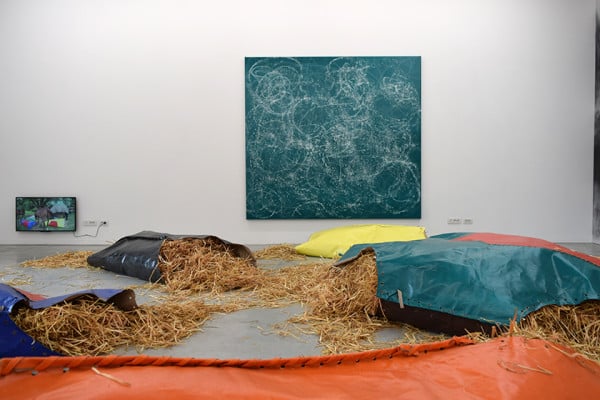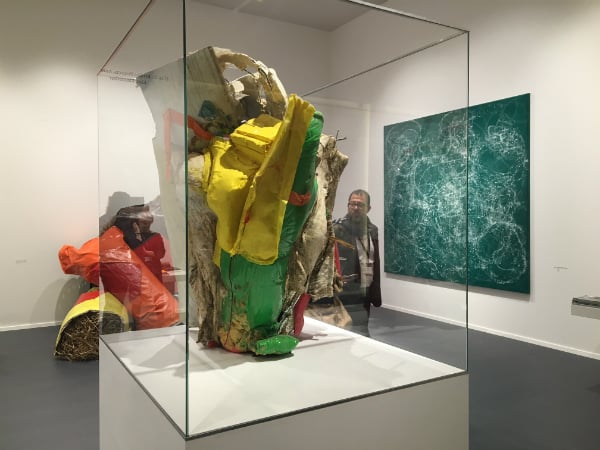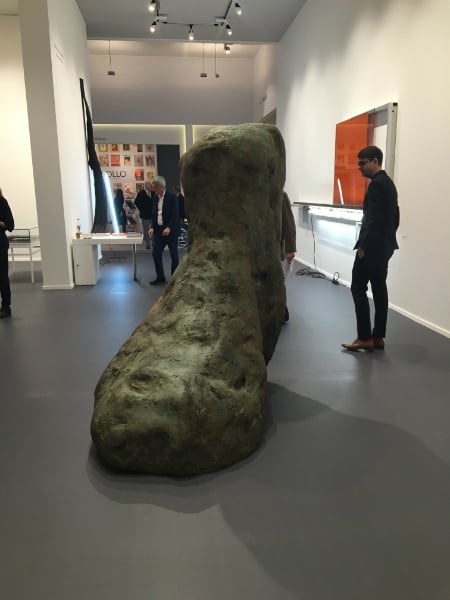
Photo: courtesy the artist

For its 2016 edition, TEFAF, the fair best known for its excellent showcases of Old Master treasures and antiquities, is testing the waters again with a curated contemporary section.
Last year, the fair launched a new exhibitors’ section-cum-exhibition with a selection of eight artists (and their main galleries) curated by Sydney Picasso. The daughter-in-law of the Spanish artist paid homage to Picasso by titling the curated section after one of his works, Night Fishing.
The new experiment in showcasing contemporary art at TEFAF was a rather cautious affair in 2015, with an artist list that was anything but risk-taking and included Georg Baselitz, Tony Cragg, and Nam June Paik, among others. This year, however, the curated section takes its title from a work by a very different seminal artist of the 20th century, Joseph Beuys, and dares to challenge visitors a little more.
Curated by Mark Kremer, “Show Your Wounds” is named after Beuys’s installation Zeige deine Wunde (1974−1975) and, as Kremer told me on preview day, the show “deals with what most of art deals with anyway—pain.” His selection included seven invited artists, all male (is “female pain” too messy for TEFAF?), and the main galleries that represent them: Klaas Kloosterboer, by Ellen de Bruijne Projects, Amsterdam; William Tucker, by Buchmann Galerie, Berlin/Lugano; Peter Buggenhout, by Galerie Laurent Godin, Paris; Helmut Federle, by Galerie nächst St. Stephan Rosemarie Schwarzwälder, Vienna; Pedro Cabrita Reis, by Sprovieri, London; John Murphy, by Galerie Nadja Vilenne, Liège; and Folkert de Jong, by Galerie Fons Welters, Amsterdam.

Installation view of “Show Your Wound” the curated section at TEFAF 2016.
Photo: Hili Perlson.
It isn’t the first time that the fair has tried to win over contemporary dealers, and several major galleries have dipped their toes in TEFAF at one stage or another: The now-defunct Haunch of Venison in 2008, Hauser & Wirth in 2009, even Gagosian in 2013. They didn’t come back.
Galerie Buchmann, however, who had their TEFAF debut at the curated section last year, did. In fact, the gallery did so well with Tony Cragg at “Night Fishing” in 2015, that they decided to also get a regular booth this time, in addition to participating at the curated show again with three bronze sculptures by Tucker, with prices ranging from €85,000 to €255,000.
“It wasn’t easy,” the gallery’s Erik Herkrath told me. “TEFAF is like a club, you have to be invited, and there’s a first-time admission fee in addition to the normal stand price.” Although the gallery didn’t divulge the fee, a fellow journalist told me it can be about €20,000. Add that to a stand price, and you easily end up with a €60,000 bill. But are collectors looking for contemporary art at TEFAF?
It surely doesn’t hurt that this year, as opposed to the previous edition, the dates don’t overlap with those of Art Basel Hong Kong. “It’s a totally different crowd, you find yourself explaining to collectors who Tucker and Cragg are, which is a nice challenge after having worked with these artists for so many years,” Herkrath said.

Installation of of William Tucker’s sculpture Uranus at TEFAF 2016.
Photo: Hili Perlson.
Other exhibitors in the curated section are here for the very first time. “I’ve never even been to the fair as a visitor,” says Ellen de Bruijne, “I just never thought it was relevant to the gallery, but when Kremer invited Kloosterboer, it changed my perspective on TEFAF.” The Dutch artist is showing an installation titled Straw Man (2015), priced at €32,000, which consists of a huge multi-colored harlequin suit, sewn out of canvases painted with enamel. It is stuffed with straw and laid against the wall. A small TV screen next to it shows the sculptural work being taken apart by horses feasting on the hay. There’s also a large painting rendered with a sanding machine that the artist had used to sand off the enamel paint from the canvas, priced at €22,000.
“I’m not sure if I would have started with a booth,” says dealer Niccolo Sprovieri, “but I liked the idea of this section.” The response to the sculptural works by Reis, two of which were created especially for the fair, has garnered “surprisingly positive responses from collectors,” he adds, commenting that the fair attracts a “quality audience.” The gallery has made new contacts and by mid-day on VIP preview, was “close to selling works” ranging from €70,000-€110,000.

Installation view of Helmut Federle at TEFAF 2016.
Photo: Courtesy of Galerie nächst St. Stephan Rosemarie Schwarzwälder.
Like most of the gallerists at the curated section, Rosemarie Schwarzwälder is also participating at TEFAF for the first time, also with one of the more established artists at the gallery. A cabinet-like presentation of works by Swiss painter Helmut Federle is attracting a crowd, and as I talk to her, collector Galila Hollander stops by to compliment Schwarzwälder on the works. Though Hollander is not a new contact for the gallery, Schwarzwälder reiterated what all other exhibitors had previously told me: not all collectors may be familiar with the artists showcased in this contemporary section, but they are very open to it, and show a lot interest.
Whether TEFAF will progressively strengthen its focus on contemporary art still remains to be seen. But, for the time being, the lure of the curated section for established, mid-to-large-sized European galleries representing recognizable artists—which there is no lack of—seems rather appealing.